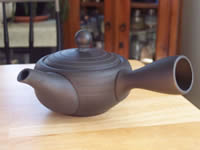Kyusu Love
I am completely enamored with teaware. I love the varied styles and colors, materials, and cultural history. Whether they be traditional “Brown Betty” pots, gaiwan, tetsubin, or gongfu pots, I’m smitten. Over the years, my collection has grown considerably. In the early days I focused far more on English-style ceramic pots of varied sizes, shapes, and colors. Then I discovered glass and clay pots and I fell completely in love. I covet sharing pitchers and trays. I can also never resist the “perfect” cup or tea bowl. While I don’t like to play favorites among my collection, my kyusu is certainly one that always catches my eye.
 A kyusu (or kyuusu) is also called a sencha teapot or, sometimes, a side-handled teapot. The handle is one of the most identifiable characteristics of this pot. Mounted to the side of the round bowl of the teapot is a long straight handle. Many times, this handle is round but hollow to lessen heat conduction. (There are also rear-handled kyusu, but the side-handled version is much more common.)
A kyusu (or kyuusu) is also called a sencha teapot or, sometimes, a side-handled teapot. The handle is one of the most identifiable characteristics of this pot. Mounted to the side of the round bowl of the teapot is a long straight handle. Many times, this handle is round but hollow to lessen heat conduction. (There are also rear-handled kyusu, but the side-handled version is much more common.)
Another important characteristic of these pots is the interior filter. The pots are designed for use with green teas and therefore require a way to screen very fine particles of teas like gyokuro. There are a few different form factors. The kyusu that I have has a stainless steel micromesh screen that surrounds the interior of the pot. Others have a stainless screen that only covers the opening to the spout. However, the best kyusu do not use the stainless steel mesh. Instead they have a special mesh filter screen called a “sasame” that is made of clay.
In general, the pots are small with thin walls so the tea is not “cooked” by the heat. The best known material would be clay from Tokoname, Japan. (Tokoname’s kilns date back to 1,100 A.D. It is one of the most historically relevant pottery centers in the country.) They may be glazed or unglazed, although I prefer the unglazed which are porous and, over time, absorb the flavor of the tea.
For me, the teaware is an important part of the tea drinking experience. What is your favorite brewing vessel?
Recent
Events
World Tea Expo
June 13-17, 2016 Las Vegas, NV
Natural Product Expo East
Sept 22-24, 2016 Baltimore, MD
Natural Product Expo West
March 10-12, 2016 Anaheim, CA